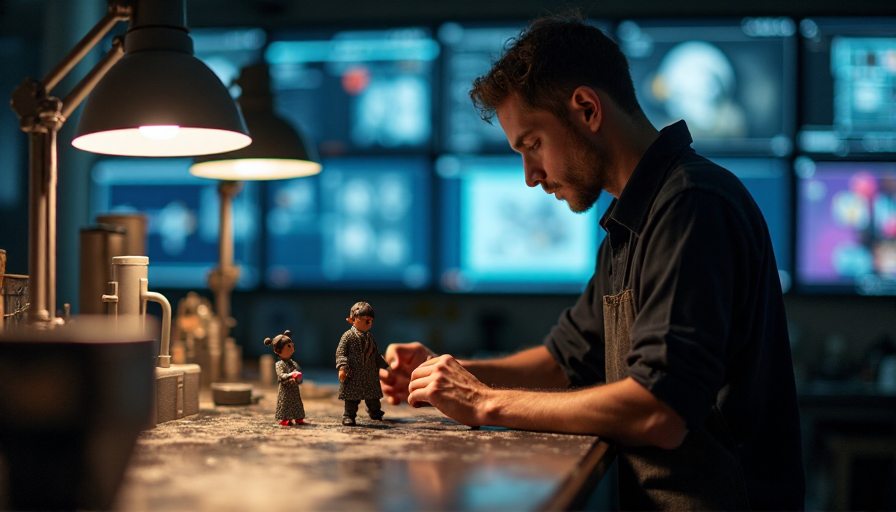
Handcrafted Resilience: Artists vs. AI-Generated Action Figures
In a world where technology increasingly influences art, a growing number of artists are rallying against the mass production of AI-generated 'starter pack' images, which transform personal photographs into doll-like figures. This move, they argue, not only risks overshadowing their unique craftsmanship but also devalues the personal touch that characterizes handmade art.
The Rise of AI-Generated Dolls
Since early April, a surge of online activity has seen thousands of users uploading their photos to generate images resembling toy dolls. Despite the allure of instant results and digital novelty, critics warn of potential drawbacks such as environmental concerns, privacy issues, and a diminishment of creative authenticity.
Nick Lavallee, a seasoned craftsman who has been hand-making custom action figures for six years, voiced his concerns in a recent interview. Having created pieces for comedians, directors, and music legends like Weezer and Tyler Childers—often selling his creations for up to $250—Nick now fears that the widespread prevalence of AI images on social media might undercut his livelihood.
"People are sick of them," Nick observed. "It's an artistic aesthetic – AI-generated art diminishes that."
Nick’s success has spurred a small business expansion, including a clothing brand, and he looks forward to opening a physical store in Manchester, New Hampshire. However, the rapid proliferation of digital replicas casts uncertainty over the future demand for his handcrafted creations.
A Creative Counter-Movement
In response to the digital takeover, a counter-movement known as #StarterPackNoAI has emerged prominently on Instagram and other social media platforms. Artists like Maria Picassó Piquer and illustrator Dav le Dessineux are embracing traditional techniques to create starter pack images that celebrate individuality and human touch.
Maria remarked on the unique diversity found in human-made art compared to the homogeneous outputs of AI. She stressed that beyond the aesthetic variety, there is a crucial facet of ownership and authenticity at stake—AI systems often assimilate styles without genuine consent, potentially impacting intellectual property rights and artists' future opportunities.
Dav, based in Bordeaux, reflected on the losses his industry has suffered, with some contracts already slipping to AI designs. Opting for the simplicity of pencil and paper, he asserted, "All you need to start being an artist is basic tools and your imagination." His work highlights a belief that true creativity stems from time, effort, and individuality—qualities that cannot be replicated by a computer.
The Value of Human Craftsmanship
Artists in various countries, including Italy and France, continue to assert that the imperfections and personal nuances in hand-crafted art confer an irreplaceable charm. Eli Dibitonto from Barletta, Italy, described his process of digitally illustrating his own starter pack as liberating and genuine, emphasizing that art is not about perfection but expression. Similarly, student illustrator Evie Joyce pointed out that producing her artwork over hours, rather than seconds, allowed her personality and experiences to shine through.
Finding Balance: Technology and Tradition
While many artists oppose the digital takeover, figures like Nick recognize that AI holds significant potential when used wisely. "I don't necessarily want to say AI is bad when I know that it could be a useful tool," Nick remarked, acknowledging his own experiments with the technology.
AI expert Henk van Ess provided a stark critique of the current trend, comparing the creation of digital starter pack images to using advanced technology for trivial tasks. He analogized it to using the Large Hadron Collider merely to heat a Pot Noodle, pointing out that such applications distract from the truly revolutionary capabilities of AI—those that address significant global challenges.
A Hopeful Future for Artisan Creators
Despite the challenges posed by digital replication, both Nick and Dav remain optimistic. Their shared conviction is that art crafted by human hands will always resonate more deeply with those who value individuality. Nick expressed hope that consumers will eventually discern the difference between computer-generated images and authentic handmade artistry. Dav echoed this sentiment by comparing the reliance on digital art to choosing pre-fabricated furniture over the skilled work of a cabinetmaker.
In an era of rapid technological change, these artists are not only defending their craft but also reminding the world of the enduring value found in human creativity and painstaking effort.
Note: This publication was rewritten using AI. The content was based on the original source linked above.